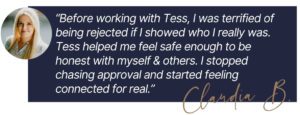Under the fear of rejection lives a quiet, painful belief that if others truly saw who we are, they’d pull away.
We learn this early. When love or approval feels conditional, our nervous system stores a deep message: It isn’t safe to be fully seen.
Even as adults, this fear can echo through our relationships, work, and creativity leaving us performing, perfecting, or pleasing instead of connecting.
Table of Contents
Why the Fear of Rejection Feels So Powerful

When fear feels louder than logic, your body is asking for safety first.
“when safety is unpredictable or love feels earned, the body learns that closeness carries risk… “
Fear of rejection isn’t simply a thought pattern, it’s a somatic survival response; the way the body protects itself from the pain of disconnection.
When our early relationships are emotionally safe, we learn attunement (how to read emotions and respond with care) and co-regulation (the trust that we can steady ourselves through connection).
However, when safety is unpredictable or love feels earned, the body learns something different: that closeness carries risk. It stays on the alert for signs of rejection; always ready to adapt or withdraw.
The fear of rejection becomes an ongoing loop: If they see the real me, they’ll leave.
Step 1: Feel the Sensation of Rejection

Start with sensation, not the story; let the body lead.
Healing fear of rejection begins by meeting it in the body, not analyzing it in the mind.
When you imagine a moment of rejection, being left out, unheard, or criticized, notice the sensations that appear: tightness, fluttering, nausea, or a clenched throat.
These sensations reveal your body’s learned beliefs about belonging. Instead of turning away, breathe into the sensations. Stay with what you feel rather than the story behind it.
Notice that feeling only the sensation is not threatening? It may be uncomfortable, but just notice, how you are able to handle this sensation.
If you focus on sensation rather than thought, you stop feeding the spiral of why and allow your nervous system to process the energy of this sensation. You get the opportunity to see it is not dangerous and that you have the capacity to be with it more neutrally.
Gradually, as you sit with it, the energy of fear begins to move and lighten. Consequently, your mind is free to engage in conscious thought.
Try this:
Remember a mild experience of rejection (something below a 6/10).
Notice where it lives in your body.
Give that place colour, texture, or shape.
Stay with it until it changes, moves, or softens.
The goal is not to eliminate fear but to let your body know it can survive the feeling.
Step 2: Welcome the Voice of Fear of Rejection

When you stop rejecting fear and start listening, healing begins.
“The scared voice often belongs to a younger version of ourselves…not who we are.”
Once you’ve felt the physical sensation, listen for the voice underneath it. That voice often belongs to a younger part of you who felt left out, unseen, or unworthy.
Normally, we push it away, but when you meet the voice of fear with curiosity, it feels heard and begins to soften. The message might appear as a word, an image, or a childlike memory.
As you listen, you may hear echoes like: Don’t show too much. Don’t need anything. Stay perfect so they’ll stay.
The Fear of Rejection is Supporting You
This voice isn’t trying to sabotage you it’s trying to protect you. It formed in a time when hiding kept you safe. Now, as an adult, you have the power to meet it with warmth and boundaries instead of shame.
This is where self-compassion and reparenting become powerful. The moment you allow that voice to exist, you begin to free yourself from it.
Each time you meet it with tenderness instead of resistance, it learns that safety is possible, not because you’ve become perfect, but because you’ve become present.
Discover What Belonging Feels Like
If you’ve spent years earning love or approval, slowing down to listen to yourself can feel foreign.
I made this simple, body-based tool for you…you’ll find calm and self-trust one step at a time.
💫 You’ll love this free one-week guide that helps your nervous system remember what calm feels like.
✦ I’m Ready to Regulate with Ease ✦ →
Step 3: Discover the Unmet Need

Every fear hides a need, listen for what wants care.
“Rejection only loses power when you stop abandoning yourself.”
Every fear of rejection hides a need for love, for inclusion, for reassurance. These aren’t weaknesses; they’re signs of your humanity and require your compassion to feel safe.
Before listening to the unmet need, try grounding your body in safety first. This can look like closing your eyes and tuning into the sensations of your feet, feeling a soft fabric on a blanket, or listening to waves. These focused inputs let your body know it is physically safe and no threat is present.
This helps you hear the fear with more presence and less reactivity.
Hearing the Fear of Rejection
Then you can tune into the voice underneath the feeling of rejection. When you ask that inner voice, What do you need?, the answer might surprise you. Perhaps it says, “I need to know I matter.” or “I want someone to stay.”
Instead of criticizing the need, or invalidating the fear by telling it: “you belong and you’re ok“. Instead, validate the fear and offer the fear compassion: “Of course you want to be loved. Everyone does.”
When you meet the need rather than suppress it, you begin to reparent the part of you that learned to hide.
Step 4: Share the Fear with Someone You Trust

Trust grows when your fear has somewhere safe to land.
“Rejection is universal and talking about it creates connection, not isolation.”
Fear thrives in isolation. When you keep your fear of rejection private, it grows stronger.
But when you share your story with someone safe, a friend, therapist, or coach, the fear begins to lose its edge.
Sharing is a form of co-regulation. It teaches your body that connection can hold fear without collapsing under it.
You’ll discover that others feel the same way. Rejection isn’t a flaw; it’s a universal human wound. And talking about it builds connection as well as a belief in your worth and ability to connect with others, even when you feel low.
Step 5: Reframe What Rejection Means

Rejection is information, not a verdict on your worth.
“Even when connection wobbles, you let go of chasing approval…”
Rejection is information, not proof of unworthiness. When someone turns away, it may reflect their limits, timing, or capacity not your value.
As you build internal safety, you stop reading rejection as danger. Instead, you see it as redirection guiding you toward people and spaces where you can be fully met.
Over time, your body starts to recognize that safety doesn’t come from pleasing or performing; it comes from honesty. You learn to stay grounded even when connection wobbles, to let go of chasing approval, and to trust that who you are is already enough.
With practice, your nervous system learns that rejection no longer defines belonging; authenticity does.
Bringing It All Together

Change begins the moment you stay with yourself.
“Instead of fear motivating you, you learn to connect based on authentic values.”
Healing fear of rejection takes time, tenderness, and consistent practice. Each time you stay present with fear, name it, and tend to what it needs, you teach your body that love doesn’t disappear when truth is seen.
When you stop rejecting yourself, others’ opinions lose their power. It becomes easier to connect with others when the fear of losing them reduces. Instead of fear motivating you, you are free to build connection with others based on authentic values and a desire for community.
You begin to live as though rejection isn’t something to avoid, it’s something you can move through and recover from.
Frequently Asked Questions – Fear of Rejection
Q1. What is the healthiest way to respond after rejection?
The healthiest response is to stay connected to yourself. Feel the sting, name what you need, and offer compassion rather than judgment. Rejection loses power when you turn toward your own care instead of away from it.
Q2. Can fear of rejection ever fully go away?
This fear can soften over time, but it may not disappear completely. Each time you meet it with presence and warmth, you build new neural pathways of safety. The more you practise this, the less control fear has over you.
Q3. How can coaching help with the fear of rejection?
Coaching provides a safe space to explore patterns, build awareness, and practise new responses. A skilled coach helps you notice what happens in your body, understand old beliefs, and develop tools that support genuine connection.
Rejection Heals Faster When You Stop Facing It Alone
Every time you turn toward the fear instead of away from it, you grow stronger. But sometimes, the old stories feel too tangled to face on your own.
That’s where guidance helps. Together, we can slow things down, listen to your body, and to rewrite the patterns that keep you guarded.

When you’re ready to feel safer being seen , not perfect, just real,
I’m here to walk with you.

